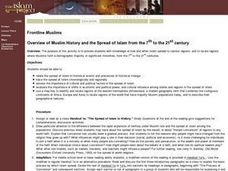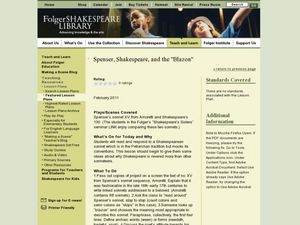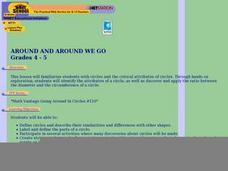Curated OER
1950's Popular Culture
Students gain a basic understanding of Capitalism and Communism, the ideologies that fueled the United States and the Soviet Union during the Cold War.
Curated OER
How is Lightning Formed
Learners research lightning paying particular attention to how it is formed, where it is most likely to occur, and how most people struck by lightning survive.
Curated OER
Frontline Muslims: Overview of Muslim History and the Spread of Islam from the 7th to the 21st century
Students gain insight into how and when Islam was spread to various regions from the 7th century to today. They are able to identify and asses the importance of cultural and political factors in the spread of Islam and the effect it has...
Curated OER
Everybody Wears Braids
Students use picture clues, patterned sentences, number words and gain knowledge of what sentences that end with a question mark look like after reading, "Everybody Wears Braids." They connect the title to their lives and make a...
Curated OER
Using Effective, Amusing Writing As a Model
Learners use the author's writing as a model to achieve vivid description and engaging humor in compositions of their own. They examine the ways a writer can capture and hold a reader's attention and write a short personal narrative...
Curated OER
Women of the Twenties and The Great Gatsby
Students research social elements of the 1920s. In this persuasive writing lesson, students make comparisons between women of the 1920s and women in the 21st century. They work in small groups to discuss the women in The Great Gatsby,...
Curated OER
Writing: A Lesson Plan on Beginnings
Students rewrite the beginning of a story. In this writing lesson, students read stories from Spooky South by S.E. Schlosser in order to gain exposure to different ways to begin a story. Then, students chose one of the three techniques...
Curated OER
Spenser, Shakespeare, and the "Blazon": Lesson 4
Students discuss the meaning and tone of Shakespeare's Sonnet 130. In this sonnets instructional activity, students compare Spenser's sonnets to Shakespeare's. Students discuss specific words that add to the humor in Shakespeare's...
Curated OER
Count And Add Nickels
This math lesson focuses on coins - specifically the nickel. Students use plastic nickles in order to gain practice counting by fives, and adding amounts of cents. Students complete a worksheet where they tally up different amounts of...
John Talavera
Autism iHelp – Sorting
Here is an app that will help kids sort objects! Sorting is an action that promotes cognitive flexibility and executive function. It is a key skill used in categorizing scientific data, making generalizations, and is foundational in...
Curated OER
The Adventures of Huckleberry Finn Packet
Readers of The Adventures of Huckleberry Finn are directed to complete two projects as a part of their study of Mark Twain’s novel. Individuals craft an organized notebook containing all their work during the study, and they research...
Novelinks
The Hitchhiker’s Guide to the Galaxy: Herber Readiness Activity
What does it mean to be alone and isolated? What would you do if you were all alone in a strange place? Kids ponder these questions as they prepare to read Douglas Adams' The Hitchhiker's Guide to the Galaxy.
Bowels Physics
Graphical Analysis
Assist your class in learning graphical analysis by reviewing the slide presentation. Class members review 15 slides to further understand concepts such as velocity and acceleration. They conclude with practice problems related to the...
BrainPOP
Latitude and Longitude Differentiated Lesson Plan
Scholars warm-up their map skills with a discussion using location words to describe familiar places. An engaging video informs class members about latitude and longitude. Three leveled activities extend the learning experience for...
EngageNY
How to Write Like a Scientist in the Field: Introduction to the Elements of Field Journals
It's time to start journaling. Scholars look at examples of science field journals. They work in pairs to examine and complete a note catcher about a field journal. They then add to an anchor chart by discussing the different features...
Curated OER
Mars Fraction Hunt
Students gain practice in the use of fractions, changing fractions, using equivalent fractions, and paying attention to detail. They divide a word into appropriate fractional parts and use equivalent fractions to correctly divide words.
Curated OER
Mars Fraction Unit
Young scholars gain practice in the use of fractions, changing fractions, using equivalent fractions, and paying attention to detail. They divide words into fractional parts. This is a fun way for kids to work with fractions.
Curated OER
BEAN and SEED MOSAIC
To gain the students' attention pose the following question: How many of you know what Cinco de Mayo is and who it is important to? After some discussions on the students' responses explain to them exactly what Cinco de Mayo is and its...
Curated OER
Trade (Hawai'i)
Students gain further understanding of the diversities of trade and the cultural impact of the trade items. Students evaluate and analyze trade items and use this knowledge to make sound trade decisions. Students describe and analyze the...
Curated OER
Save Our Soil
Learners gain an understanding of the small amount of soil available to sustain humans on earth and complete an appropriate graph or chart from their collected data. They locate some of the countries they have heard about where people do...
Curated OER
Around and Around We Go
Fourth graders discover that a polygon is a closed figure formed by line segments, and that the perimeter of a polygon is the sum of the lengths of its sides. They utilize a worksheet imbedded in this plan to gain lots of practice with...
Curated OER
WINTER-STORYTELLING
The student evaluate illustrations in a book, identify a story or book as distinctly Native American, draw original illustrations for a story, create a flip book, listen attentively to stories from a known storyteller, act out a story,...
Curated OER
Identifying Linear Functions from Graphs
Keep your mathematicians engaged using this group linear functions activity. Each of ten groups receives two graphs with both an image and equation, as well as a "who has" phrase to call out the next graph. Scholars stay on their toes as...
Briscoe Center for American History
Mary Maverick and Texas History - Part 2
To conclude their investigation of the life of Mary Maverick and to demonstrate their ability to analyze primary source documents, groups use the SOAPS questioning method to examine Maverick's account of events in early Texas history.

























